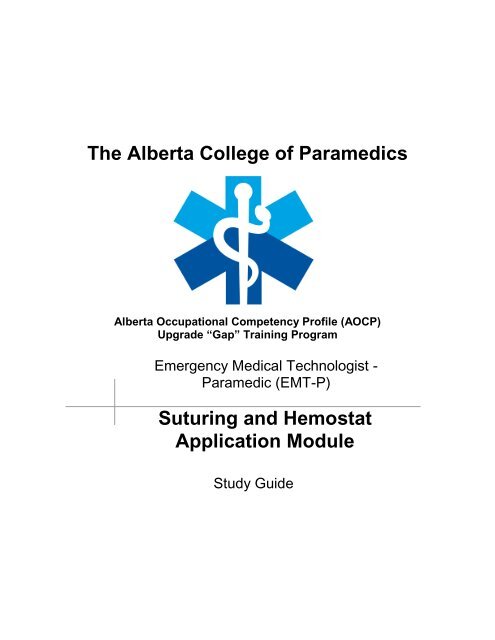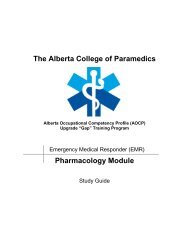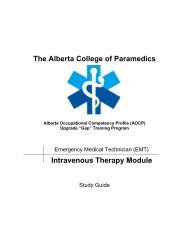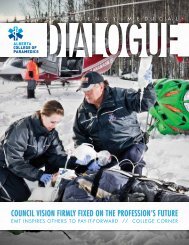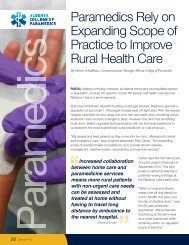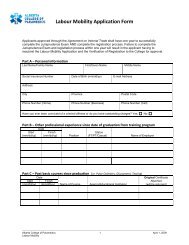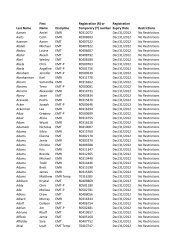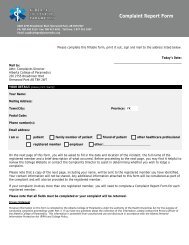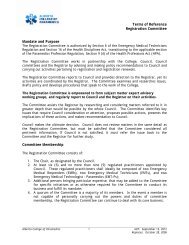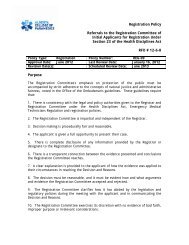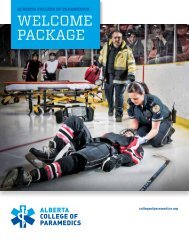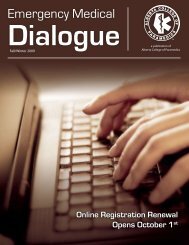Suturing and Hemostat - Alberta College of Paramedics
Suturing and Hemostat - Alberta College of Paramedics
Suturing and Hemostat - Alberta College of Paramedics
You also want an ePaper? Increase the reach of your titles
YUMPU automatically turns print PDFs into web optimized ePapers that Google loves.
ABOUT THE AOCPMost <strong>of</strong> the competencies have been learned in basic education; othercompetencies have been acquired through advanced education, on the job training,<strong>and</strong> experience. All EMRs, EMTs <strong>and</strong> EMT-Ps have the basic competencies;however, competency on the job will vary depending on job requirements, <strong>and</strong>policy <strong>and</strong> procedure <strong>of</strong> the employing agency.The Pr<strong>of</strong>ile provides a cumulative view <strong>of</strong> the competencies within the Scope <strong>of</strong>Practice <strong>and</strong> within the general <strong>and</strong> specialized areas <strong>of</strong> that practice.The <strong>College</strong> has developed the following educational module for upgrading theknowledge <strong>and</strong> skills <strong>of</strong> registered practitioners to meet the <strong>Alberta</strong> OccupationalCompetency Pr<strong>of</strong>iles (AOCP), the new Regulation <strong>and</strong> scope <strong>of</strong> practice.HISTORY OF THE PROCESSOn March 4, 2000, the Paramedic Association <strong>of</strong> Canada adopted the NationalOccupational Competency Pr<strong>of</strong>ile (NOCP), which included both a newclassification <strong>and</strong> generic competencies for four pr<strong>of</strong>essional designation levels <strong>of</strong>Paramedicine.On March 22, 2000, the <strong>Alberta</strong> <strong>College</strong> <strong>of</strong> <strong>Paramedics</strong>’ Council made thecommitment that the <strong>Alberta</strong> <strong>College</strong> <strong>of</strong> <strong>Paramedics</strong> AOCP would meet or exceedthe NOCP.ACKNOWLEDGEMENTS<strong>Alberta</strong> <strong>College</strong> <strong>of</strong> <strong>Paramedics</strong>Continuing Competency Ad Hoc Education Committee Members:Douglas Britton, MEM, EMT-P, ChairRenee Linssen, EMR, Vice-ChairWilliam Coghill, MEM, EMT-P, CHCARuth Farrow, EMT-P, MLTChristine Patterson, MEM, EMTRichard Poon, BSc., EMT-P, MEdMarilyn Ringness, BSc., EMT-PBarry Straub, EMT-PDonna Lefurgey, CEO/RegistrarLaurie Mitchell, Registration Division LeaderPackage Development <strong>and</strong> DesignPortage <strong>College</strong> Prehospital Care ProgramsLac La Biche, <strong>Alberta</strong>In collaboration with…<strong>Alberta</strong> <strong>College</strong> <strong>of</strong> <strong>Paramedics</strong>Continuing Competency Ad Hoc Education Committee<strong>Alberta</strong> <strong>College</strong> <strong>of</strong> <strong>Paramedics</strong>Introduction to the Upgrade “Gap” Training Programii
EMT- P – S uturing <strong>and</strong> <strong>Hemostat</strong>CompetenciesThis module meets the following competencies <strong>of</strong> the <strong>Alberta</strong> OccupationalCompetency Pr<strong>of</strong>ile (AOCP).I-6 Perform External Hemorrhage ControlI-6-2 Perform wound closure with sutures:• List the indications for wound closure.• Perform a simulation <strong>of</strong> wound closure with sutures.• List <strong>and</strong> describe complications <strong>and</strong> contraindications <strong>of</strong> woundclosure with sutures.I-6-3Perform hemostat application:• List the indications for hemostat application.• Perform a simulation <strong>of</strong> hemostat application.• List <strong>and</strong> describe complications <strong>and</strong> contraindications <strong>of</strong> hemostatapplication.EMT-P – <strong>Suturing</strong> <strong>and</strong> <strong>Hemostat</strong> 2
Objective 1Demonstrate the Knowledge <strong>and</strong> Ability to PerformSimple <strong>Suturing</strong> TechniquesIn order to perform suturing, a paramedic must have a good underst<strong>and</strong>ing <strong>of</strong> theanatomy <strong>and</strong> physiology <strong>of</strong> the skin. The skin has many important functionsincluding, but not limited to, protection, thermoregulation, <strong>and</strong> sensory reception.<strong>Suturing</strong> aids the skin in the role <strong>of</strong> protection. The skin protects the body <strong>and</strong>underlying tissue from mechanical injury, infection <strong>and</strong> fluid loss.The skin consists <strong>of</strong> two layers, the epidermis <strong>and</strong> dermis. The epidermis is theoutermost layer <strong>and</strong> can be up to 0.5 mm thick. The epidermis has no vasculature<strong>and</strong> receives required nutrients by diffusion from vessels located in the dermislayer.The dermis layer lies below the epidermis. The dermis is thicker than theepidermis <strong>and</strong> is supplied with nerves, arteries, blood <strong>and</strong> lymphatic vessels.Closure <strong>of</strong> the dermis with suturing helps prevent further blood loss <strong>and</strong> reducesthe introduction <strong>of</strong> foreign materials.<strong>Paramedics</strong> will use suturing for two main purposes. The first is for the control <strong>of</strong>bleeding <strong>and</strong> infection (most common) <strong>and</strong> the second is for definitive care in thehospital or clinical setting. Wounds sutured by paramedics will be superficial,requiring simple sutures for treatment. Wounds requiring deep or layered suturesrequire greater skill <strong>and</strong> expertise than superficial wounds <strong>and</strong> should not beattempted in the pre-hospital setting.ContraindicationsWhen suturing to control hemorrhage there are no absolute contraindications.This is an immediate <strong>and</strong> interim solution, as bleeding cannot be controlled by anyother means.However, for regular closure <strong>of</strong> wounds that are not life threatening there are somecontraindications. Where scar tissue may be <strong>of</strong> concern for aesthetic or functionalreasons, it is advised that paramedics avoid suturing these areas. The face <strong>and</strong>h<strong>and</strong>s are two such areas. Other contraindications include:• Wounds where debridement cannot be properly achieved.• When sterility cannot be ensured <strong>and</strong> there is a possibility <strong>of</strong> infection.• Bite wounds should not be sutured due to the high incidence <strong>of</strong> infection.• Any unstable patient where rapid treatment <strong>and</strong> transport would be delayed.EMT-P – <strong>Suturing</strong> <strong>and</strong> <strong>Hemostat</strong> 5
Equipment <strong>and</strong> SuppliesDepending on circumstances <strong>and</strong> conditions expected, it is suggested that MedicalDirection be consulted in the use <strong>of</strong> local anesthetics. In order to perform suturingyou will need the following equipment:• Needle Driver• Toothed Forceps• Suture Scissors• Sutures With Needle• Local Anesthetic• Syringe <strong>and</strong> Needle for Administration <strong>of</strong> Local AnestheticThere is a wide variety <strong>of</strong> suture material available for use. It is generallyclassified using four criteria:• Composition• Characteristics <strong>and</strong> performance• Absorption <strong>and</strong> reactivity• Size <strong>and</strong> tensile strengthSutures are composed <strong>of</strong> natural or synthetic materials, mon<strong>of</strong>ilament (singlestr<strong>and</strong>) or multifilament (braided) as well as absorbable or non-absorbablematerials. The type <strong>of</strong> suture used will depend on the expected healing time <strong>of</strong> thearea to be sutured <strong>and</strong> the tensile strength required. For example fine sutures are<strong>of</strong>ten used for suturing the face as it heals quickly, does not have a high stressload, <strong>and</strong> minimizing scar tissue is a consideration. On the other h<strong>and</strong>, suturing <strong>of</strong>the knee or other high stress area requires a stronger more durable suture materialas will take longer to heal, <strong>and</strong> is under constant stress from movement.The numbers associated with each various suture indicates the tensile strength <strong>and</strong>size <strong>of</strong> the suture material. The more zeros in the number, the smaller the str<strong>and</strong><strong>and</strong> the less tensile strength it has. For example, a suture with a number <strong>of</strong> 3-0(meaning 000) is smaller <strong>and</strong> weaker than a suture with a number <strong>of</strong> 2-0 (meaning00).There are also a variety <strong>of</strong> needles that can be used when suturing. Needles consist<strong>of</strong> three sections: the eye, body <strong>and</strong> point. The eye, as with most needles, is forthreading the suture material through so it is attached to the needle. The body <strong>of</strong>the needle can be straight or curved. This is part <strong>of</strong> the needle that is held by theneedle driver. The curved needles differ from each other not only in size but alsoin the amount <strong>of</strong> curve each one has. Some have a smooth finish <strong>and</strong> others can befound with a cutting edge along the entire length, to aid in its ability to cut throughtissue. The tip or point <strong>of</strong> the needle is designed to be cutting, tapered or blunt.These are designed to penetrate all types <strong>of</strong> different tissue for suturing.EMT-P – <strong>Suturing</strong> <strong>and</strong> <strong>Hemostat</strong> 6
The gauge <strong>of</strong> needle <strong>and</strong> material will range in size as well. Again, smaller sizesare used for more delicate work such as suturing a face, <strong>and</strong> the larger sizes forsituations where the needle <strong>and</strong> material must be stronger, such as suturing a kneewhere the skin is thicker <strong>and</strong> tougher.Each material <strong>and</strong> needle combination has its own advantages <strong>and</strong> disadvantages.Typically a curved cutting needle (FS1) with medium gauge (3-0 or 4-0) synthetic,mon<strong>of</strong>ilament material (Ethilon), will be used in the pre-hospital setting.Depending on circumstances <strong>and</strong> conditions expected, it is suggested that MedicalDirection be consulted in the choice <strong>of</strong> sutures used in individual service areas.FreezingThe use <strong>of</strong> freezing in cases where time permits, will ease the discomfort <strong>of</strong> thepatient during the procedure. It is very important to maintain sterility whiledrawing up the anesthetic. The anesthetic should be drawn up using a large boreneedle such as an 18g, <strong>and</strong> then infused using a small bore needle such as a 22gauge or 25guage needle.The pain <strong>of</strong> injection can be decreased by dripping small amounts <strong>of</strong> the anestheticdirectly into the wound prior to injection. The anesthetic is then instilledsubcutaneously by sliding the needle into the tissue from inside the open wound,parallel to the surface tissue. The medication is injected while withdrawing theneedle. This procedure is repeated in a circular fashion around the exposed edge <strong>of</strong>the wound.The st<strong>and</strong>ard local anesthetic is lidocaine in a 1% (10mg/ml) or 2% (20mg/ml)preparation. Some preparations will contain small amounts <strong>of</strong> epinephrine, usuallyin a 1:100,000 concentration, which is sufficient to decrease bleeding within thewound by causing, localized vasoconstriction. Fingers, toes, penis, nose, <strong>and</strong> earsare areas <strong>of</strong> the body with limited blood flow <strong>and</strong> are contraindicated for the use <strong>of</strong>local anesthetic containing epinephrine.Lidocaine toxicity is always a concern so it is imperative to record the totalamount <strong>of</strong> local anesthetic given. The maximum dose is 3 mg/kg before signs <strong>and</strong>symptoms <strong>of</strong> systemic toxicity may occur. Treatment <strong>of</strong> Lidocaine toxicity issupportive. The following are common signs <strong>of</strong> lidocaine toxicity.• Central nervous system: light-headedness, dizziness, nystagmus, sensorydisturbances, restlessness, disorientation, <strong>and</strong> psychosis. Slurred speech,muscle twitching, <strong>and</strong> tremors will <strong>of</strong>ten precede seizures• Cardiovascular: Signs <strong>and</strong> symptoms <strong>of</strong> cardiac toxicity include hypotension,bradycardia, <strong>and</strong> cardiac arrest.Wound PreparationAfter determining the need to suture our patient, the first step is to clean thewound. In most cases <strong>of</strong> field suturing, the wound will be opened up on arrival atthe hospital so intense debridement is not required. Instead the focus should be onEMT-P – <strong>Suturing</strong> <strong>and</strong> <strong>Hemostat</strong> 7
These are things that can only be learned through practice <strong>and</strong> attention to detailwhile working with an experienced clinician.The Square KnotThe square knot is the knot <strong>of</strong> choice for simple suturing <strong>and</strong> tying it with the use<strong>of</strong> the needle driver will be discussed.The square knot is a common knot that we are all familiar with. We perform half asquare knot when we tie our shoes. To practice a complete square knot, take apiece <strong>of</strong> string several inches long <strong>and</strong> place it on a table. Place the ends acrosseach other resulting in a circle. Adjust the circle so there is one long end <strong>and</strong> oneshort end <strong>of</strong> string with the short end passing over the long end.Next, pass the short end under, then over the loop creating the first “throw”. Tocreate the second “throw” <strong>of</strong> the knot, grasp the two ends <strong>and</strong> pass the short endover the long end. At this point you should have two circles touching each other.Continue to wrap the short end under, then over the long end. Pull snuggly <strong>and</strong>you have created a square knot. To create a knot with the sutures that will hold theskin together, you will be required to “stack” two square knots on top <strong>of</strong> eachother.Please Note: To see a visual representation <strong>of</strong> tying the square knot please refer tothe following website:http://www.bumc.bu.edu/Dept/Content.aspx?departmentid=69&PageID=5260Tying the square knot with sutures is best understood by viewing thedemonstration on the following web site:http://www.bumc.bu.edu/Dept/Content.aspx?departmentid=69&PageID=5263Interrupted StitchThe interrupted stitch is the most common we will see for final closure <strong>of</strong> awound. It is a series <strong>of</strong> stitches along the length <strong>of</strong> the wound, each being tiedindividually. They should be equidistant from each other <strong>and</strong> from the edges <strong>of</strong> thewound. They should not put excessive tension on the skin causing blanchingwhich may lead to necrosis. Once each knot is tied the thread is cut thus allowing anew stitch to begin.Continuous StitchThe continuous or running stitch is easiest for quick closure <strong>of</strong> wounds that willbe opened later for surgery or debridement. It allows for faster suturing since itonly has a knot tied at either end. It also allows for swelling to occur within thewound with less tissue damage since the pressure will be relieved as the wholesuture line will flex <strong>and</strong> exp<strong>and</strong> instead <strong>of</strong> each individual stitch tearing to relievethe pressure.The continuous or running stitch begins just like the interrupted stitch. However,once the knot is tied do not cut the thread. Instead, move the needle to the sitewhere you would like to make the next stitch <strong>and</strong> proceed through the skin. OnceEMT-P – <strong>Suturing</strong> <strong>and</strong> <strong>Hemostat</strong> 9
you have exited the skin on the other side <strong>of</strong> the wound, do not tie <strong>of</strong>f the thread,simply move along to the next insertion site for the needle.Continue down the length <strong>of</strong> the wound pulling the stitch snug as you go. Once atthe end <strong>of</strong> the wound, cross the wound from your last exit point to the entry pointfor that stitch <strong>and</strong> tie <strong>of</strong>f the end <strong>of</strong> the thread using the last stitch as the “shortend” for your knot.Although this can be used as a temporary stitch in the pre-hospital setting, it is bestto leave the wound open <strong>and</strong> protect it from further contamination by covering thewound with sterile dressings. “Temporarily” closing a wound that has not beenproperly cleansed can result in a serious infection.Figure-Of-Eight StitchThis is the “stitch <strong>of</strong> choice” for any bleeding that cannot be controlled by thecombination <strong>of</strong> direct pressure, elevation <strong>and</strong> the use <strong>of</strong> pressure points. To usethis suturing technique the vessel that is bleeding must be superficial <strong>and</strong> easilyisolated. This technique involves inserting a continuous stitch, which will form afigure-<strong>of</strong>-eight around the vessel. Then by tying the beginning tail <strong>of</strong> the suture tothe end tail <strong>and</strong> applying tension, it will indirectly constrict the vessel by pullingthe tissue around the vessel together until it can no longer bleed. This technique isnot used for the regular closing <strong>of</strong> a wound.Scalp wounds are the primary example <strong>of</strong> when this stitch could be used. Becausesome <strong>of</strong> the arteries that supply blood to the head lie between the skull <strong>and</strong> the thinlayer <strong>of</strong> skin, which is our scalp, they are both superficial <strong>and</strong> easily isolated. Notto mention, bleeding in this area can be difficult to control due to the large bloodsupply provided by the superficial temporal artery <strong>and</strong> the occipital artery.Objective 1: Key TermsThrowSquare knotNeedle driverInterrupted stitchContinuous stitchFigure Eight StitchSuperficial temporal arteryOccipital arteryEMT-P – <strong>Suturing</strong> <strong>and</strong> <strong>Hemostat</strong> 10
Objective 2Discuss the use <strong>of</strong> <strong>Hemostat</strong>s for the Purpose <strong>of</strong>Hemorrhage ControlThe use <strong>of</strong> hemostats as a skill for the control <strong>of</strong> bleeding has been around formany years. In spite <strong>of</strong> this, there is limited research available on the use <strong>of</strong>hemostats for this purpose. In fact, some <strong>of</strong> the only information found indicatedit was not generally advisable, as it can cause necrosis <strong>of</strong> the vessel making itdifficult to repair. There are always theoretical situations where hemostats couldbe <strong>of</strong> benefit to control bleeding in the prehospital setting, however, there is noevidence to substantiate them. The practitioner should bear in mind the potentialfor damage versus any benefit <strong>of</strong> using this skill when making a decision.To begin we must we must reflect on BLS procedures to control bleeding. Weshould consider making use <strong>of</strong> the following prior to using hemostats in the case<strong>of</strong> bleeding:• Direct pressure – pressure must be applied to the wound otherwise theb<strong>and</strong>age may simply act as a wick to draw more blood out.• Elevation – above the level <strong>of</strong> the heart.• Pressure point – applied proximal to the injury.• <strong>Suturing</strong> & TourniquetsOnly after exhausting all preceding options should hemostat application beconsidered.When considering hemostat application for the control <strong>of</strong> otherwise uncontrollablebleeding we must ascertain the viability <strong>of</strong> the skill in the situation as well asweigh the cost versus benefits.• Is this a life over limb situation?• Are the vessel ends accessible or have they retracted into the tissue?• Can you visualize the vessel or are they accessible only by feel?• Are we willing to risk nerve damage to the area since the nerves are in closeproximity to the vessels <strong>and</strong> could be clamped by accident?If after considering these questions you decide that clamping the vessel is the onlyoption available to you <strong>and</strong> the patient, then you must proceed cautiously, <strong>and</strong>preferably under direct medical control.When clamping with hemostats you must use enough pressure to occlude thevessel while being gentle enough to not crush it. You must clamp only vessels thatcan be visualized, as blind clamping is likely to cause damage to nervous tissue. Itis suggested that a combination <strong>of</strong> direct pressure <strong>and</strong> suturing will lead to greatersuccess with less risk than hemostat application.EMT-P – <strong>Suturing</strong> <strong>and</strong> <strong>Hemostat</strong> 11
As you can see, the use <strong>of</strong> hemostats is not a first line procedure for the control <strong>of</strong>hemorrhage. If you determine it is the only option, the situation is life over limb<strong>and</strong> medical control has seen fit to allow hemostat application in your service,proceed with care <strong>and</strong> patience making sure not to cause any more damage to thepatient.Objective 2: Key TermsDirect pressureElevationPressure point<strong>Suturing</strong>TourniquetsEMT-P – <strong>Suturing</strong> <strong>and</strong> <strong>Hemostat</strong> 12
SummaryThe goal <strong>of</strong> this module is to review the skills <strong>of</strong> suturing <strong>and</strong> hemostatapplication. As you have noted from the literature, hemostat application is quitecontroversial even in the hospital under the care <strong>of</strong> a physician. It should be usedas a last resort, if at all.Ongoing practice <strong>and</strong> perfection <strong>of</strong> the skills covered in this module is necessaryto obtain <strong>and</strong> maintain competence. As the Paramedic scope <strong>of</strong> practice increases,the onus is even greater to ensure your knowledge remains current <strong>and</strong> that youresearch the pros <strong>and</strong> cons <strong>of</strong> all procedures.EMT-P – <strong>Suturing</strong> <strong>and</strong> <strong>Hemostat</strong> 13
Exam1. While suturing we need to maintain sterile technique.a. Trueb. False2. By approximating the wound we are:a. Aligning skin <strong>and</strong> tissue to its original position.b. Recording approximately where it lies on the body.c. Assessing approximate depth.d. Determining approximately what size sutures to use.3. For which reason would we consider suturing prehospitally?a. Remote location.b. Treat <strong>and</strong> release.c. Uncontrolled hemorrhage.d. No physician at receiving hospital.4. Placement <strong>of</strong> the stitches should be:a. Sporadic.b. Equidistant from the end <strong>of</strong> the wound.c. Equidistant from edge <strong>of</strong> the wound.d. Equidistant from both the edge <strong>of</strong> the wound <strong>and</strong> each other.5. What structures do we suture prehospitally?a. Ligaments.b. Muscle tissue.c. Dermis.d. Subcutaneous tissue.6. Of the following, which should be used to control bleeding prior to theapplication <strong>of</strong> hemostats?a. Direct pressure.b. Elevation.c. Tourniquets.d. All <strong>of</strong> the above.7. Using a combination <strong>of</strong> hemorrhage control techniques may be moreadvisable than hemostat application.a. Trueb. FalseEMT-P – <strong>Suturing</strong> <strong>and</strong> <strong>Hemostat</strong> 14
8. Complications <strong>of</strong> poor technique in placing hemostats include:a. Tissue damage.b. Nerve damage.c. Vessel damage.d. All <strong>of</strong> the above.9. Blind clamping <strong>of</strong> vessels should be considered common practiceprehospitally.a. Trueb. False10. Which <strong>of</strong> the following statements is TRUE regarding hemostat application?a. <strong>Hemostat</strong>s are easy to use.b. <strong>Hemostat</strong>s are the first method used to control bleeding.c. Current literature does not support widespread use <strong>of</strong> hemostatsprehospitally for the control <strong>of</strong> bleeding.d. Only good <strong>Paramedics</strong> are allowed to use them.EMT-P – <strong>Suturing</strong> <strong>and</strong> <strong>Hemostat</strong> 15
Glossary <strong>of</strong> TermsObjective 1: Key TermsThrow – Crossing the ends <strong>of</strong> the suture to form a loop <strong>and</strong> then wrapping one end<strong>of</strong> the suture around the other.Needle driver – A self-clamping hemostat that is utilized to grasp a suture needle.Square knot - the knot <strong>of</strong> choice for simple suturing.Interrupted stitch - A series <strong>of</strong> stitches along the length <strong>of</strong> the wound, each beingtied individually.Continuous stitch – A continuous stitch along the entire length <strong>of</strong> the wound. Ithas only two knots: one at the beginning <strong>and</strong> one at the end.Figure Eight Stitch – This is the “stitch <strong>of</strong> choice” for uncontrolled bleeding.Superficial temporal artery – is the main blood supply <strong>of</strong> the scalp. It is thecontinuation <strong>of</strong> the external carotid artery.Occipital artery –supplies blood to the posterior region <strong>of</strong> the scalp.Objective 2: Key TermsDirect pressure – Method <strong>of</strong> hemorrhage control that relies on the application <strong>of</strong>pressure to the actual site <strong>of</strong> the bleeding.Elevation – Movement in which a body part moves superiorly.Pressure point – Any <strong>of</strong> the various points on the body where pressure can beexerted to relieve pain or control the flow <strong>of</strong> arterial blood.<strong>Suturing</strong> – A stitch or series <strong>of</strong> stitches made to secure apposition <strong>of</strong> the edges <strong>of</strong> asurgical or traumatic wound.Tourniquets – A device for compression <strong>of</strong> an artery or vein.EMT-P – <strong>Suturing</strong> <strong>and</strong> <strong>Hemostat</strong> 16
ReferencesMiller – Keane (1997), Encyclopedia & Dictionary <strong>of</strong> Medicine, Nursing & AlliedHealth, (Sixth Edition). Philadelphia, P.A.:W.B. Saunders CompanyRoberts (2004), Clinical Procedures in Emergency Medicine, (4th edition). StLouis MO: Elsevier Inc.http://www.bumc.bu.edu/Dept/Content.aspx?departmentid=69&PageID=5260http://www.bumc.bu.edu/Dept/Content.aspx?departmentid=69&PageID=5263EMT-P – <strong>Suturing</strong> <strong>and</strong> <strong>Hemostat</strong> 17
Appendix AEMT-P – <strong>Suturing</strong> <strong>and</strong> <strong>Hemostat</strong> 18
Lab Skills ChecklistSUTURINGApply PPE precautions.Perform patient assessment.Obtain history <strong>and</strong> baseline vital signs.Determine treatment plan.List indications, contraindications <strong>and</strong> complications for this procedure.Explain procedure to patient/family <strong>and</strong> obtain consent.Assemble equipment/ supplies <strong>and</strong> prepare patient for procedure.Cleans/debride wound.Apply sterile gloves <strong>and</strong> set up sterile field.Approximate edges to be sutured <strong>and</strong> determine type <strong>of</strong> stitch or forhemorrhage control must use the figure-<strong>of</strong> eight stitch.Infiltrates with local anesthetic if required.Ensure sutures are equidistant from the edges <strong>of</strong> the wound <strong>and</strong> each other.Assess individual knots for tension <strong>and</strong> proper approximation <strong>of</strong> woundedges.Remove sterile field.Dress the wound.Reassess patient <strong>and</strong> note any complications.Document the procedure.Comments:Instructor Name & Initials: __________________ Date: ____________________EMT-P – <strong>Suturing</strong> <strong>and</strong> <strong>Hemostat</strong> 19


